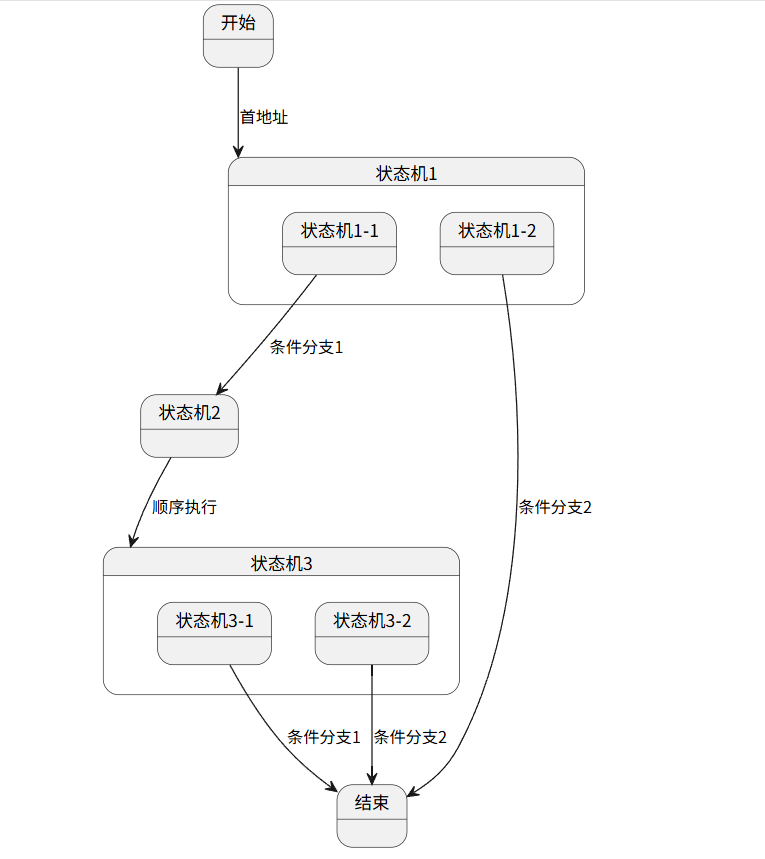【嵌入式】【调用函数图】手动绘制函数调用状态机
文章目录
模块设计
转化流程
- 在CSV文件中标明函数调用流程
- 将CSV文件转化为JSON标识文件
- 将JSON文件转化为函数STATE
- 将函数STATE绘制成PLANTUML
- 将PLANTUML图转为markdown文件
文件格式说明
见下文示例。
功能示例
输入配置

输出图示

代码部署
JSON文件操作模式
import osimport sysimport jsondef load_json(filepath, filename): # 打开并读取 JSON 文件 filetotal = os.path.join(filepath, filename) with open(filetotal, \'r\', encoding=\'utf-8\') as jsonfile: # 指定编码避免乱码 data = json.load(jsonfile) # 解析为 Python 对象(字典/列表) jsonfile.close() return datadef save_json(data, filepath, filename): filetotal = os.path.join(filepath, filename) with open(filetotal, \'w+\', encoding=\'utf-8\') as jsonfile: # 指定编码避免乱码 json.dump(data, jsonfile, indent=4, ensure_ascii=False) # 格式化+支持中文[1,4,7](@ref) jsonfile.close() return dataCSV文件操作模块
import csvimport jsondef csv_to_json(csv_path, json_path): with open(csv_path, \'r\', encoding=\'utf-8\') as csv_file: csv_reader = csv.DictReader(csv_file) # 自动解析表头为键 data = [row for row in csv_reader] # 逐行转为字典列表 with open(json_path, \'w\', encoding=\'utf-8\') as json_file: json.dump(data, json_file, indent=4, ensure_ascii=False) # 美化输出并支持非ASCII字符# 调用示例if __name__ == \"__main__\": print(__file__) csv_to_json(\'input.csv\', \'output.json\') print(\"end\")函数调用状态绘制
import osimport sysimport jsonFUNC_NAME = \"函数块\"FUNC_NOTE = \"函数块注释\"FUNC_DEPT = \"函数块深度\"FUNC_CHAIN_TYPE = \"状态顺序链\"FUNC_JUMP_NOTE = \"状态跳转说明\"FUNC_TYPE = \"类型\"FUNC_LINE_NOTE = \"注释\"FUNC_JUMP_TARGET = \"跳转函数\"FUNC_CHAIN_TYPE_TRUE = \"Y\"FUNC_CHAIN_TYPE_FALSE = \"N\"ROOT = \"ROOT\"class State: def __init__(self): self.body = {} self.body[FUNC_NAME] = \"\" self.body[FUNC_NOTE] = \"\" self.body[FUNC_DEPT] = \"\" self.body[FUNC_CHAIN_TYPE] = \"\" self.body[FUNC_NOTE] = \"\" self.body[FUNC_TYPE] = \"\" self.body[FUNC_LINE_NOTE] = \"\" pass def update_dept(self, state_new): self.body[FUNC_DEPT] = str(int(eval(self.body[FUNC_DEPT], eval(state_new.body[FUNC_DEPT])))) pass def __str__(self): print(self.body) return \"\"depth_cnt = 0def print_plantuml_init(stateTree, stateArray, note, umlfile): global depth_cnt for sonnode in stateTree[note[0]]: if sonnode[1] != FUNC_CHAIN_TYPE_TRUE: continue depth_cnt +=1 print(\" \"*depth_cnt, \" \".join([\"state \\\"\", stateArray[sonnode[0]][FUNC_NOTE], \"\\\" as\", stateArray[sonnode[0]][FUNC_NAME], \"{\"]), file = umlfile) print_plantuml_init(stateTree, stateArray, sonnode, umlfile = umlfile) print(\" \"*depth_cnt, \"}\", file = umlfile) depth_cnt -= 1 returndef print_plantuml_jump(jsonArray, stateArray, umlfile): for linek in jsonArray: if linek[FUNC_JUMP_TARGET] in stateArray.keys(): print(\" \", linek[FUNC_NAME], \"-down->\", linek[FUNC_JUMP_TARGET], \":\", \"\", linek[FUNC_JUMP_NOTE], \"\", file = umlfile) pass returnclass StateArray: def __init__(self, jsonArray, filename): self.jsonArray = jsonArray self.stateArray = {} self.stateTree = {} for arrk in jsonArray: func_name = arrk[FUNC_NAME] if func_name in self.stateArray.keys(): pass else: self.stateArray[arrk[FUNC_NAME]] = arrk pass self.update_state_chain() with open(filename, \"w+\", encoding=\"utf-8\") as umlfile: print(\"```plantuml\", file= umlfile) print(\"@startuml\", file= umlfile) print_plantuml_init(self.stateTree, self.stateArray, (ROOT, FUNC_CHAIN_TYPE_TRUE, \"ROOT\"), umlfile = umlfile) print_plantuml_jump(self.jsonArray, self.stateArray, umlfile=umlfile) print(\"@enduml\", file= umlfile) print(\"```\", file= umlfile) pass def update_state_chain(self): last_state_stack = [] # 遍历所有函数 for statek in self.stateArray.keys(): if not last_state_stack: last_state_stack.append(statek) if statek in self.stateTree.keys(): print(statek, self.stateArray[statek], \"duplitate state line\") else: self.stateTree[statek] = [] pass # 建立根结点 self.stateTree[ROOT] = [] state_top_depth = eval(self.jsonArray[0][FUNC_DEPT]) for idxk in range(0, len(self.jsonArray)): statek = self.jsonArray[idxk][FUNC_NAME] statek_depth = eval(self.jsonArray[idxk][FUNC_DEPT]) if statek_depth == state_top_depth: self.stateTree[ROOT].append((statek, self.jsonArray[idxk][FUNC_CHAIN_TYPE], self.jsonArray[idxk][FUNC_JUMP_NOTE])) pass # 建立子结点 for idxk in range(0, len(self.jsonArray)): statek = self.jsonArray[idxk][FUNC_NAME] statek_depth = eval(self.jsonArray[idxk][FUNC_DEPT]) for idxm in range(idxk+1, len(self.jsonArray)): statem = self.jsonArray[idxm][FUNC_NAME] statem_depth = eval(self.jsonArray[idxm][FUNC_DEPT]) if statek_depth + 1 == statem_depth: self.stateTree[statek].append((statem, self.jsonArray[idxm][FUNC_CHAIN_TYPE], self.jsonArray[idxm][FUNC_JUMP_NOTE])) if statek_depth >= statem_depth: break pass pass return def __str__(self): for statek in self.stateArray.keys(): print(statek, self.stateArray[statek]) print(self.stateTree) return \"\"主函数调用入口
import osimport sysimport timeimport jsonimport csvimport globimport module.module_json as mdjsonimport module.module_csv as mdcsvimport module.module_state as mdstatedef create_csv2json(filepath, filename): totalname = os.path.join(filepath, filename) jsonname = filename+\".json\" jsontotalname = os.path.join(filepath, jsonname) mdcsv.csv_to_json(totalname, jsontotalname) return filepath, jsonnamedef create_json2state(filepath, filename): totalname = os.path.join(filepath, filename) jsonarray = mdjson.load_json(filepath, filename) print(mdstate.StateArray(jsonArray=jsonarray, filename=totalname + \".md\")) return jsonarrayif __name__ == \"__main__\": filepath = r\".\\statecsv\" filename = r\"demo.csv\" jsonpath, jsonname = create_csv2json(filepath=filepath, filename=filename) create_json2state(jsonpath, jsonname)

